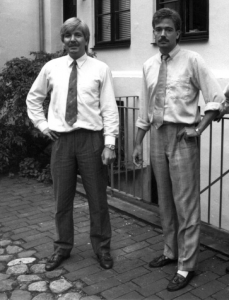An Idea That Eventually Turned Out to Be Worth $1.45B
When Erik Damgaard in the summer of 1983 returned to Denmark from his six months at the University of South Carolina, he had learned to program.
When his friend, Morten Gregersen, in the spring of 1984, showed him a CP/M based accounting system, that with a price tag of $1,500 sold around 100 copies a month, he believed that he could make a better and more user-friendly product.
So he started programming.
Booking $100,000 in the first week
At the annual Danish computer fair in October 1984, Erik and his brother Preben Damgaard presented the integrated business management system Maxisoft to the visitors. The price tag was $2.450 for a single user license. They sold 40 licenses during the fair and engaged with a handful of resellers that wanted to bundle hardware and software and provide service and support to customers.
Selling to Microsoft for $1.45B
 Fast forward from 1984 to 2002 and Microsoft acquires Navision for $1.45B in cash. Navision was then only 18 months old and the merger of Damgaard and Navision Software, and Erik and Preben Damgaard were still among the principal shareholders.
Fast forward from 1984 to 2002 and Microsoft acquires Navision for $1.45B in cash. Navision was then only 18 months old and the merger of Damgaard and Navision Software, and Erik and Preben Damgaard were still among the principal shareholders.
My forthcoming book “5,460 Miles from Silicon Valley: The In-depth Case Study of What Became Microsoft’s First Billion Dollar Acquisition Outside the USA” provides all the details of what happened between 1984 and 2002. Making it from the original idea to something that Microsoft would pay $1.45B for was by no means a walk in the park, but the original idea was not particularly sophisticated. It was an improvement of something that already existed.
In 1986 Erik released Concorde which was an improved version of the previous product now taking advantage of the capabilities of the PC and MS-DOS. With a large base of resellers in place, sales accelerated very fast and enabled Damgaard Data to hire more people and embark on even more ambitious development projects.
Concorde XAL
 In 1991 Erik and his team launched Concorde XAL. That was an innovative product and a great leap forward for the company. It turned out that the product was an excellent fit with the reseller based business model. The product included an SDK that enabled the resellers to customize the product and to develop additional functionality. For each dollar in license fees to Damgaard Data the reseller made ten dollars in auxiliary revenue on services where he kept the full gross margin. Concorde XAL was a business enabler for the resellers.
In 1991 Erik and his team launched Concorde XAL. That was an innovative product and a great leap forward for the company. It turned out that the product was an excellent fit with the reseller based business model. The product included an SDK that enabled the resellers to customize the product and to develop additional functionality. For each dollar in license fees to Damgaard Data the reseller made ten dollars in auxiliary revenue on services where he kept the full gross margin. Concorde XAL was a business enabler for the resellers.
An improvement of what we already know may not be such a bad idea
Navision Software started the same way. Their first product PCPLUS (1985) was a single user accounting system for the PC. It did what many other products did, but it had a user-friendly design. It sold well and gave Navision Software the financial foundation for making more advanced products later on.
Improving something that already exists by making it easier to use, less expensive, faster to implement or adding some other convenience features is a viable way to start a business. It can be kicked off with little investment and you don’t have to do missionary work to convince customers to solve a problem they don’t know they have.
You can get all the details in the book (coming out in English in June 2018).









